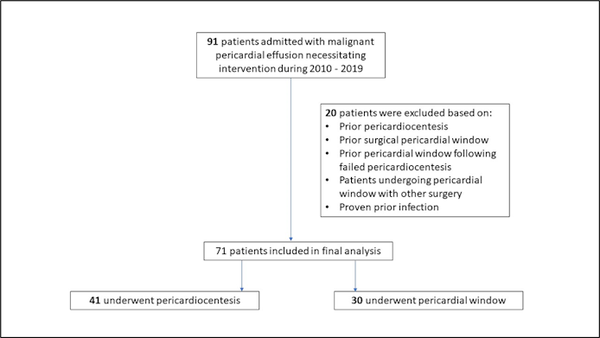-
Home
-
About JCTR
-
Gold Open Access
-
Issues
-
Editorial board
-
Author guidelines
-
Publication fees
-
Online first
-
Special issues
-
News
-
Publication ethics
-
Partners
-
Submit your manuscript
-
Submit your review report
-
Editorial Office
-

This work is licensed under a Creative Commons Attribution-NonCommercial 4.0 International License. ISSN print: 2382-6533 ISSN online: 2424-810X
Volume 9 Issue 3
Best management of patients with malignant pericardial effusion: a comparative study between imaging-guided pericardiocentesis and surgical pericardial window
Abdul Baqi*, Intisar Ahmed, Pirbhat Shams
Baqi et al. J Clin Transl Res 2023; 9(3):10
Published online: June 2, 2023
Abstract
Background: The clinical course of malignancies is frequently complicated by third-spacing in body cavities, including pericardial effusion. What remains the optimal management for malignant pericardial effusion, is a dilemma.
Aim: We aimed to compare 30-day outcomes of imaging-guided pericardiocentesis and surgical pericardial window in patients with malignant pericardial effusion.
Methods: A retrospective observational study was done at a tertiary care hospital. We reviewed hospital record files of 91 consecutive patients admitted with malignant pericardial effusion from January 2010 to December 2019 and requiring imaging-guided pericardiocentesis or pericardial window.
Results: A total of 71 patients were included in the final analysis. Most patients were male (68%). The mean age was 45 years. Hypertension was the most common comorbid condition. Lymphoma or leukemia (39%) was the most common cause of malignant pericardial effusion followed by lung cancer (28%). 57.7% of patients underwent pericardiocentesis, and the remainder underwent surgical pericardial window (42.3%). The overall procedural success was 97.2%, and the overall mortality was 5.6%. The success rate was similar when pericardiocentesis was compared with the surgical pericardial window (p = 0.22). The length of hospital stay was higher in patients undergoing pericardial window (p = 0.007), whereas the re-accumulation rate was higher in the pericardiocentesis group (0% versus 34%, p < 0.001). Patients undergoing pericardial window had higher odds of major bleeding requiring transfusions.
Conclusion: There is a higher rate of recurrence following isolated pericardiocentesis but a comparable mortality difference between the two procedures. Complication rates can be reduced by improving surgical technique and peri-operative management. Meticulous surgical care, infection precautions, and good glycemic control in this immunocompromised sub-set can preserve the pericardial window as a better management option.
Relevance for patients: Pericardial window is a promising and effective management option for patients with recurrent malignant pericardial effusion, but it comes at the cost of bleeding and infection. More extensive trials are needed to understand better the long-term outcomes of pericardial window or pericardiocentesis in patients with malignant effusion.

DOI: http://dx.doi.org/10.18053/jctres.09.202303.010
Author affiliation
Section of Cardiology, Department of Medicine, Aga Khan University, Karachi, Pakistan
*Corresponding author
Abdul Baqi
Section of Cardiology, Department of Medicine, Aga Khan University, Karachi, Pakistan.
Tel: +92 3337766688
Email: Abdul.baqi@aku.edu
Handling editor:
Michal Heger
Department of Pharmaceutics, Utrecht University, the Netherlands
Department of Chemistry, Utrecht University, Utrecht, the Netherlands
Department of Pathology, Erasmus Medical Center, the Netherlands
Department of Pharmaceutics, Jiaxing University Medical College, Zhejiang, China

